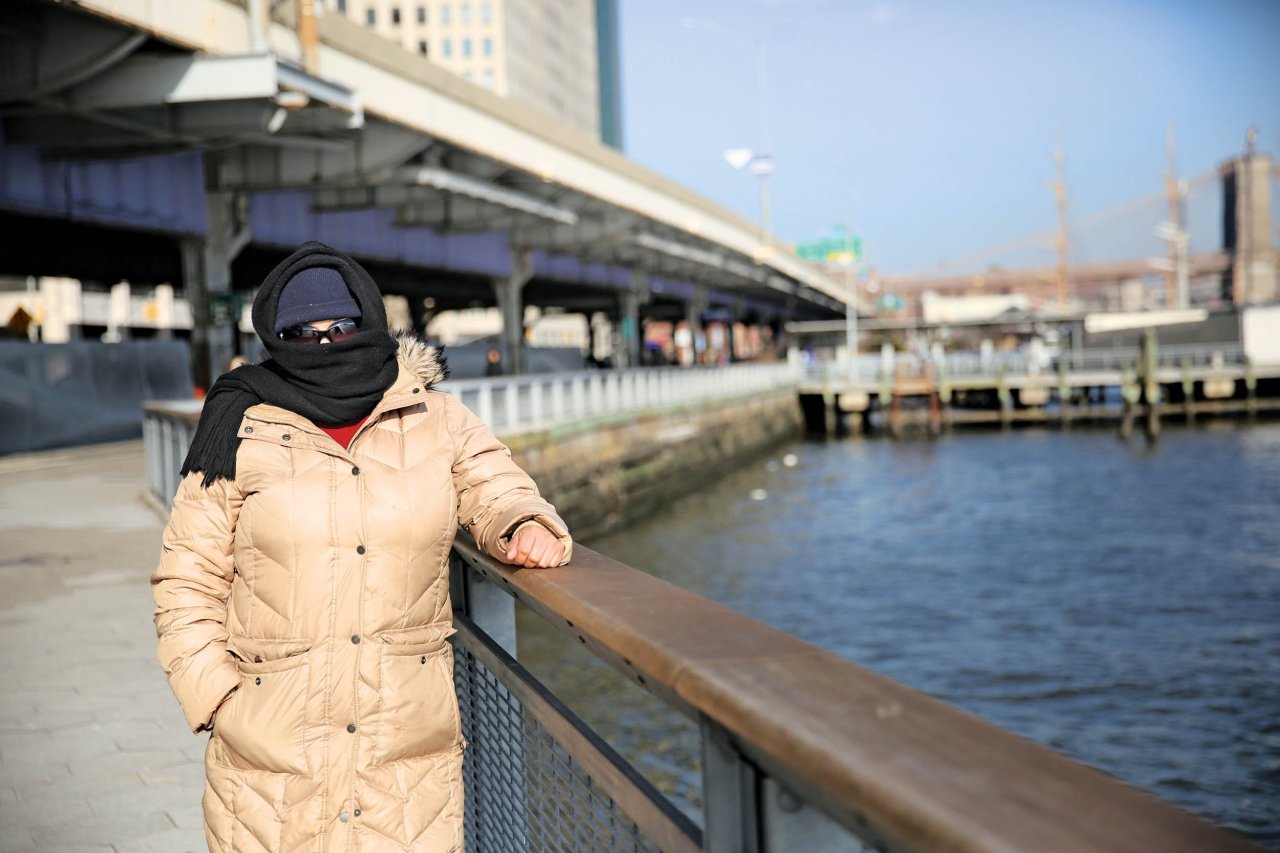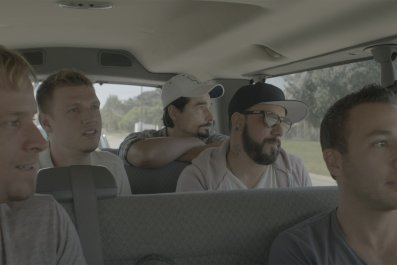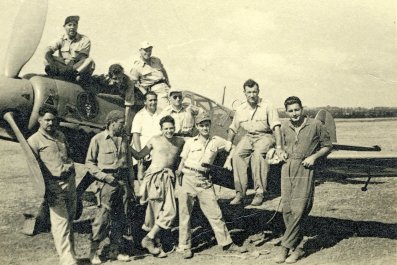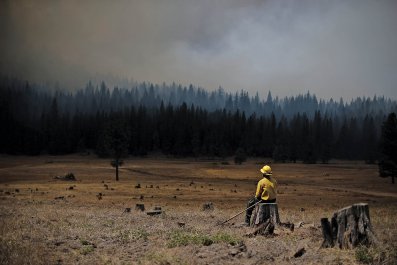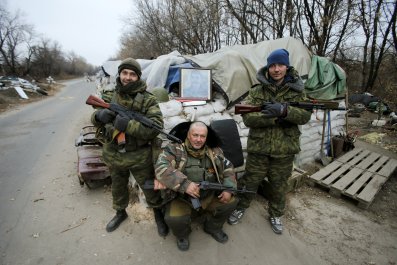From the passenger seat of the red Camaro convertible hurtling away from Southampton Road, Janet watched the scenery change from one-story houses to tobacco fields and apple orchards. She had come to Charlotte, North Carolina, to work on a farm, but she wasn't going to be picking—she and the three other women in the car were wearing high heels and see-through miniskirts, and they felt alone and afraid.
The thought of the violence to come terrified them. It was midday, and after about an hour on the road, the man behind the wheel, whom the women knew as Ricardo, a common fake name traffickers use, turned down a dirt path and stopped at a cluster of cheap cabins that had floors lined with mattresses. These beat-down shacks were home for more than 100 farm workers. In the main farm house nearby, the workers—mostly from Mexico, El Salvador, Honduras and Guatemala—were on their lunch break, eating chicken and rice.
The four women climbed out of the Camaro and went over to sheds near the cabins, where the workers kept their tools. The cement floors inside had crumbled through, exposing big dirt holes. While the women laid down rags, the men, filthy and reeking of sweat after spending all morning in the fields, quickly finished eating and formed lines outside the sheds, with as many as 50 men waiting for a woman. Ricardo stayed by the car, keeping lookout for police or anyone who might try to rob him and the women.
One by one, the men paid $30 to rape Janet and the other women. Most of them, having gone a long time without sex, lasted only a few minutes with Janet. Some were so violent she was sure they would have seriously hurt or even killed her if it weren't for Ricardo, watching over the operation. She remembers seeing that happen once, to a woman who came without a driver or a pimp; she says the farm workers threw the body in a dump.
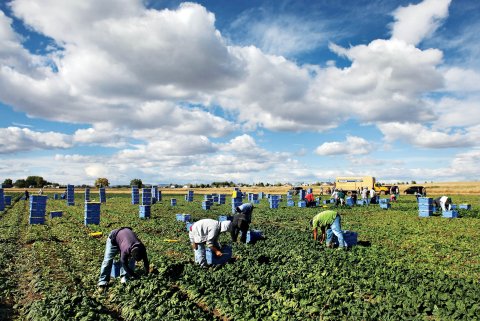
At the end of the day, as the sun was setting, the women handed all the money they'd collected to Ricardo, and they made the drive back to Charlotte. In the car, all Janet wanted to do was rest, but she knew she had to call her pimp, hundreds of miles away, and report how many customers she had had and how much money she made. As soon as she arrived in Charlotte, Janet knew there would be johns waiting for her at the brothel. The next day would be the same routine, and that thought made her hate herself. She felt inhuman, like a machine.
Janet was forced into prostitution in Mexico by a boyfriend named Antonio in 1999; coyotes brought them across the border the following year, and they went to live with Antonio's family in the borough of Queens in New York City, where she was put to work in brothels. Every couple of weeks, a van would take her and other women and girls—some as young as 12—to Charlotte, where she would spend a week or more, forced to have sex with strangers at a brothel by night and at farm labor camps by day.
Sex trafficking flourishes in areas of male-dominated industries, such as fracking and oil boomtowns, military bases and, as a slew of recent court cases and victim accounts show, farm labor camps. The U.S. Department of State estimates that traffickers bring some 14,500 to 17,500 people into the United States each year.
"These organizations that victimize these women…transport them to where the business is," says James T. Hayes Jr., special agent in charge of Homeland Security Investigations in New York. Traffickers set up shop in metropolitan areas—they often choose Queens for its central location along the Eastern corridor to cities north and south, plus its big clientele base in New York City—and send women to farms near and far, ranging from Vermont to Florida. Officials don't know how many women are trapped in this city-to-farm sex pipeline, but experts say the number is growing every year. Keith V. Bletzer, an adjunct faculty member at Arizona State University who has studied prostitution in agricultural areas, says that until recent years, women went to farm labor camps on their own to sell sex out of financial necessity. Now, however, there is an organized crime element, with "other people recognizing that this might be a viable" source of income, he says. Rather than women selling sex to make a living, it's traffickers bringing them to farms as part of larger international operations.
In some cases, pimps posing as boyfriends lure victims and shuttle them from brothel to brothel. In other instances, coyotes smuggle women across the border and then force or coerce them into selling sex to pay off smuggling fees. The United Nations says criminals who once trafficked weapons and drugs have made women their latest commodity. "It's hugely profitable," says Lori Cohen, director of the anti-trafficking initiative at Sanctuary for Families. Smuggled drugs are quickly sold, but with a woman, "you bring her across the border once and you just keep using her body over and over again until she breaks down," she explains.
For Janet, who requested that Newsweek refer to her by the name she used most when she was a prostitute, that breakdown took more than a decade. "Your body is being sold," she says in Spanish through a Sanctuary for Families advocate. "It's almost like your body is no longer yours."
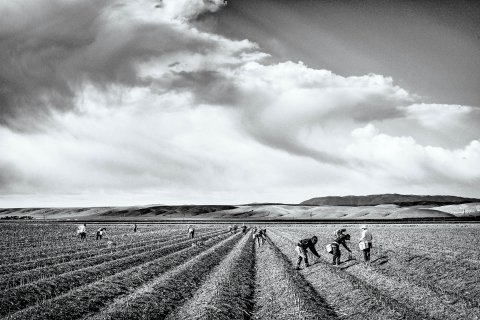
Her First Time
Widely considered the sex trafficking capital of the world, Tenancingo, Mexico, is two hours southeast of Mexico City. Many of the town's 10,000 residents are involved in prostitution; for young men, becoming a pimp means joining the family business. "It's a sex-trafficking city," says Human Trafficking Intervention Court Judge Toko Serita, "where generations of families and men are engaged in the business." Men there "recruit" women from elsewhere in Mexico, often by pretending to fall in love with them, and then bring them to Tenancingo, where the forced prostitution begins. From there, many pimps take their victims to work in Mexico City; some later go to the U.S., where there is more money to be made.
Janet grew up with her grandmother in Puebla, a half-hour drive from Tenancingo. "My childhood was very poor, but I have memories that make me laugh," she says. One day in 1998, when Janet was 23, she was walking home from her factory job when a car pulled up beside her. "Hi, my name is Ricardo," the man inside the car said. "Can I accompany you?"
"No," Janet said. "I don't know you."
The man persisted and asked if they could be friends. When they reached Janet's home, she finally said OK, they could be friends. Having recently split from the abusive father of her young daughter, Janet wasn't eager to bring someone new into her life. But the man from the car kept showing up. "He was very respectful of me. In Puebla, when a woman gets into a car with a man, the first thing the man does is he starts grabbing her. He wants to take you immediately to bed," she says. This man, however, "behaved very nicely."
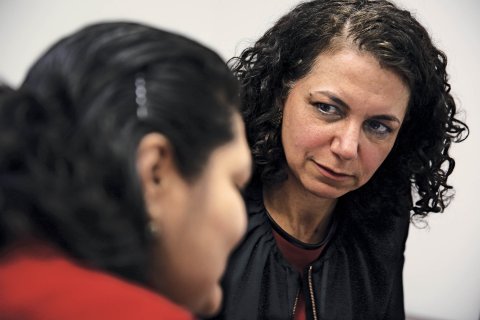
In July 1999, after knowing Ricardo for a little more than year, Janet agreed to move in with his family in Tenancingo, leaving her daughter in the care of her grandmother. But when she arrived, she learned that his name was Antonio, not Ricardo, and that he was a pimp. His family lived in squalor, even worse than where Janet had grown up. Antonio's family slept in one room, and the animals they owned slept in another. Water poured in through the ceiling when it rained, and children ran around barefoot and played with soiled diapers. After six months, Janet decided to leave Antonio, but discovered she was pregnant and stayed.
That's when the abuse began. First, Antonio forced Janet to take pills so she would have a miscarriage. She did. Weeks later, he told her she had to become a prostitute. At first she protested, saying she had worked a good job in a factory and could find work like that again. But he insisted, and eventually she gave in. Her first time selling sex was on the streets of Mexico City. During that time, she recalls, "[the sex] was day and night and I felt terrible." After a year, Antonio told her that if they went to the U.S., family there could help them find legitimate work. Reluctantly, Janet agreed, and in June 2000 they made their way across the border and to Queens.
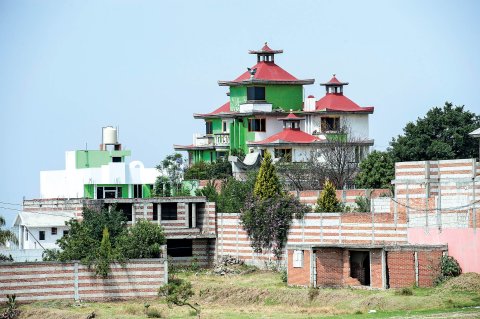
'Set Up to Be Invisible'
The vast majority of the country's estimated 3 million farmworkers were born outside the U.S. Like Janet, most of them came to America in search of opportunity and, also like Janet, are being steadily ground down by a system working against them. Few suburban supermarket shoppers know that federal labor laws exclude farmworkers from certain rights most Americans take for granted, such as overtime pay, days off and collective bargaining. State by state, advocates have tried to change that, but Big Agriculture usually manages to thwart the efforts.
Seasonal crop farm laborers typically live in barracks for a few months at a time. At year-round livestock farms, workers live in cheap houses or trailers. "The average citizen wouldn't see them," Renan Salgado of the Worker Justice Center of New York says about where the workers live. "They are set up to be invisible." Because of their undocumented status, workers rarely leave the farms, relying instead on supervisors and middlemen to deliver everything from groceries to medical aid to women.
The scene is a volatile mix, ripe for violence. "People are just bored, and they're lonely," says Gonzalo Martinez de Vedia, also of the Worker Justice Center. "You have an entire population that is sitting at home for an entire season. Single men. There's a lot of drinking, substance abuse."
Workers tend to take out that frustration on female visitors. What happens on the farms, says Cohen, is rape. "I think there's a perception that when…you pay to have sex with someone, that means that you pay for the right to do whatever you want with that woman," she says. "The violence that our clients have experienced at the hands of their buyers is really shocking."

Hold the Children Hostage
Antonio had promised a better life for Janet north of the border, but their living conditions in Queens were horrific. "People were sleeping one on top of another, and all the women worked in prostitution," she says. Antonio's cousins were pimps, she learned, operating a family ring. Janet still had to sell sex, and a routine developed: Antonio would spend his days playing soccer and billiards, while Janet had to work at brothels in Queens and Boston. Once Antonio learned about the opportunity to sell sex to farmworkers, he began sending Janet to Charlotte. There, a white, one-story, three-bedroom house near the end of a winding road served as a brothel, offering johns a constant rotation of out-of-state women. Janet and the other victims would see men there from 7 at night to 3 in the morning, sleep until 11 a.m. and then be driven out to the farms.
"I felt like an animal," Janet says. "The men were very aggressive. They would grab me. They were pushing me. They would grab me by the neck. They would penetrate me really hard. So when they finished, it was like my salvation." Many men appeared to be on drugs; some refused to pay. She tried to make them wear condoms, but sometimes the condoms would break or the men would take them off. Janet says she had so many abortions—always done with Cytotec pills, widely used in the trafficking world—that she lost track of how many. She lived in constant fear. "I didn't even like to look at them," she says of her buyers.
Antonio still promised they would get married, and he told Janet he was sending the money she earned back to Mexico, where someone was building them a house. Antonio's cousins told their victims similar lies to keep them hoping and in line. "The traffickers are canny. They've figured out the sort of sweet spot that needs to be exploited," Cohen says. "It's almost like a script." The traffickers would also threaten that if a woman ran away or went to the police, they would harm her family back in Mexico. For one ring that serviced farmworkers, prosecutors learned the pimps went so far as to impregnate their victims just so they could hold the children hostage.
"The fear that the trafficking organizations place into their victims makes it sometimes difficult if not impossible to get a victim to actually admit that they're a victim," says James Hayes Jr. from Homeland Security Investigations. Sadly, some victims go to great lengths to protect their traffickers or return to their pimps, despite the help of law enforcement and advocates.
Around 2009, one of the pimps in Antonio's ring was arrested for domestic abuse, and Antonio fled to Mexico. However, he stayed in contact with Janet by phone and expected her to continue working and wiring him money. Meanwhile, Janet was in touch with her daughter, who was still in Mexico and had medical expenses stemming from an accident. To cover those expenses, Janet asked Antonio if she could use some of the money she made, but he refused. So she went to the Mexican Consulate in New York City for advice, and after she described her predicament, consulate staff contacted Sanctuary for Families.
That visit to the consulate set in motion an investigation by U.S. Immigration and Customs Enforcement, beginning in 2010. Investigators conducted surveillance and pored over phone, travel and financial records, in order to identify and locate key members of the ring. With Janet's help, officials rescued 25 victims, arrested the pimps and found Antonio hiding in Mexico. In 2012, officials extradited him, and he was sentenced in June 2014. He and three cousins all pleaded guilty and are now serving sentences ranging from 15 to 22 years.
The path that led Antonio to trafficking became clear in court materials. He was an orphan at the age of 6, after his mother abandoned him and his father died of alcoholism; an uncle in Tenancingo took him in but routinely beat him with a whip and starved him; he grew up without schooling, friends or affection. Coming of age in Tenancingo, his lawyer wrote in a memorandum, Antonio saw "a culture that not only tolerated sex trafficking, but flaunted it with the showy extravagances of its participants." Antonio told his lawyer, "I wanted to be somebody."
The judge sentenced Antonio to 15 years behind bars, plus five years of supervised release. He must register as a sex offender and pay Janet $1.2 million in restitution, which will come from the money he made as a pimp and whatever he makes in prison job programs. While in prison, he will pay at least $20 per month, serving as a constant reminder of what he did.
On the day of the sentencing, appearing in a Brooklyn courtroom as Jane Doe No. 1, Janet finally confronted the man who had enslaved her for 11 years. "He did not treat me like a human being. He treated me like a sexual robot," she said in court. "For years I cried in silence. I carried the scars of Antonio's abuse every day, but I can no longer be silent. I am here today so Antonio and his family will no longer be able to force another woman into prostitution."

'The Fresh Meat Is Here'
The details from Janet's account are consistent with those another victim and multiple farmworkers provided to Newsweek. In New York, one former dairy farmworker in Lewis County says that once a week, a man would go to the farm with women and knock on workers' doors, saying, "Llego la carne fresca" ("The fresh meat is here") and "Tu vas a pasar" ("You are up"). Someone who provides services to farmworker camps in upstate New York says that his weekly farm visits coincide with those of the indentured women, and that the workers always tell him to hurry and serve them food before it's their "turn" for sex. Rates with the women range from $25 to $60.
"They're essentially prisoners, and they don't have free time, so it's easier for them when they're offered that opportunity, it's just right there," a former farmworker, Arturo Vasquez, who worked in upstate New York, said in Spanish through an advocate affiliated with the Robert F. Kennedy Center for Justice and Human Rights. He said he'd seen Latin American women on farms, as well as Chinese and Russian women.
A victim who asked that Newsweek refer to her as Katarin, the name she used as a prostitute, says she endured years of forced prostitution at farm labor camps. She was only 13 in 2010 when her future pimp approached the park bench where she was sitting in a village near Puebla after finishing her work shift at an ice cream shop. The boy, 16, introduced himself. She thought he was handsome, and after a week they were romantically involved. Three weeks after they met, she went to live with his family in Tenancingo. Five months later, they crossed the border by foot with smugglers into Arizona. Then they took a van to Queens, and three days later, he forced her into prostitution.
Katarin remembers drivers taking her to farms on Long Island, as well as in Delaware, New Jersey and Pennsylvania. She would see 30 to 40 men a day in bunks ridden with bedbugs; many of the men were violently drunk, and some would use knives or scissors to break open their condoms. "Sometimes they couldn't come because they were drinking so much, and they would get really mad because the time would be up and they hadn't finished," Katarin says in Spanish through Sanctuary for Families. By 2014, she had developed a vaginal infection that left her in unbearable pain, and when her pimp said she had to continue working, she decided to escape. She went to the police, who helped get her to a hospital and a safe house.
Her pimp ran away and remains at large.
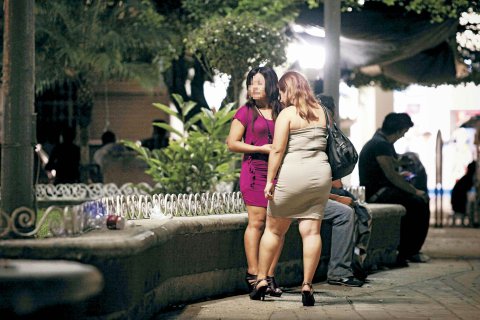
Mr. All That
The man responsible for bringing down Antonio's ring is James Hayes Jr., who oversees the New York office for Homeland Security Investigations. Immigration work runs in Hayes's family; his grandfather was a customs inspector, and his father worked for the Immigration and Naturalization Service and U.S. Customs and Border Protection. In the mid-1990s, interested in a career in law enforcement, Hayes, now 41 and a Brooklyn native, chose border patrol over the New York Police Department. From there, he moved to Los Angeles to take down gangs, and he entered his current role in 2009. Since then, he says, his office has rescued more than 250 trafficking victims and made at least 150 trafficking-related arrests.
The case involving Janet's trafficker was one in a handful involving farmworker camps to go to court in recent years. In May 2014, following another bust by Hayes, a judge found two Mexican brothers guilty of running a ring that operated four brothels and trafficked women to farms in New Jersey. The brothers got life in prison, believed to be New York state's first life sentences for sex trafficking. Fifteen other members of the ring faced charges, including one man whose job was to sweep cars for tracking devices. "We saw with both [rings] very sophisticated levels of organization and very sophisticated delineations of responsibilities," Hayes says. Prosecutors believe the brothers' ring started as far back as 1999 and involved hundreds, and possibly thousands, of women.
In 2011, Hayes's Homeland Security Investigations counterpart down South, Brock Nicholson, helped bust the brothel in Charlotte where Janet had been shipped. In 2013, the Georgia attorney general announced an anti-trafficking campaign that singled out "rural communities where young girls are trucked in to be abused by farmworkers." And last February, Nicholson's five-year investigation into a Savannah-based ring, dubbed Operation Dark Night, concluded with the conviction of 23 defendants. At least two of the dozen victims Nicholson rescued had been forced to have sex with migrant laborers in sweet potato fields in Georgia and the Carolinas.
The problem exists in the Midwest too. In October, Michigan officials in Lenawee County, a rural area outside of Toledo, Ohio, accused a local man of trafficking two American women in their 20s to farmworkers there. "We've been investigating [sex trafficking to] migrant farms for years," says R. Burke Castleberry Jr., the county prosecuting attorney.
Two separate cases, prosecuted between 2011 and 2013, involved transporting women from Queens to farms in Vermont for sex. In one, which involved at least five women, the liaison between the pimp and farmworkers was a caseworker at the Vermont Department for Children and Families. He had taken advantage of the fact that workers depended on him for goods and services, and supplied them with not only clothing, for which he marked up the prices, but also women. His business cards said, "Don Chingon," which roughly translates to "Mr. All That." (There may be an added pun, since the verb chingar can mean "to have sex.") Prosecutors in both Vermont cases failed to prove that the women were trafficking victims, and so the men faced charges related only to interstate prostitution.
Hayes says his office is pursuing dozens of human trafficking cases. "Whether they're being taken to farms or nightclubs or apartments," he says, "we're focused on putting an end to it."
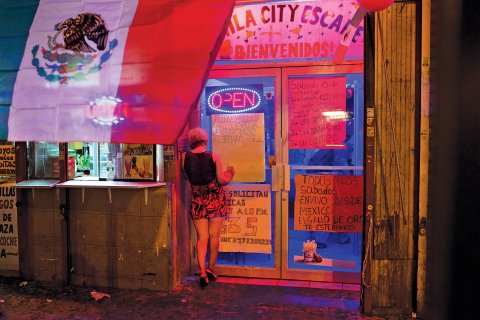
"I Wanted Love"
It's been several months since Janet confronted Antonio in court. She sits in a conference room on the 28th floor of a building in midtown Manhattan wearing a black jacket and purple shirt, her hair pushed back with a headband. There are panoramic views, but she focuses on the table in front of her, using a pencil to sketch her childhood home in Puebla. That was where she was happiest and felt safest, a time of blue quinceanera dresses and Christmas turkey dinners. Growing up there, she learned from her grandmother the importance of loving relationships. "I wanted to have a real marriage with love," she says. "It's something permanent."
Seeing Antonio locked up has brought some closure to Janet, now 38, though she continues to struggle with her past. "I lost the best moments of my life, when I could have been with my family," she said in court. Living in the U.S. on a special visa for trafficking victims, she has reunited with her daughter, now a teenager. These days, Janet attends counseling and has the support of a boyfriend, though she doesn't tell her friends her full story. She's escaped the clutches of slavery, but knows there are millions of people who are still in chains.



